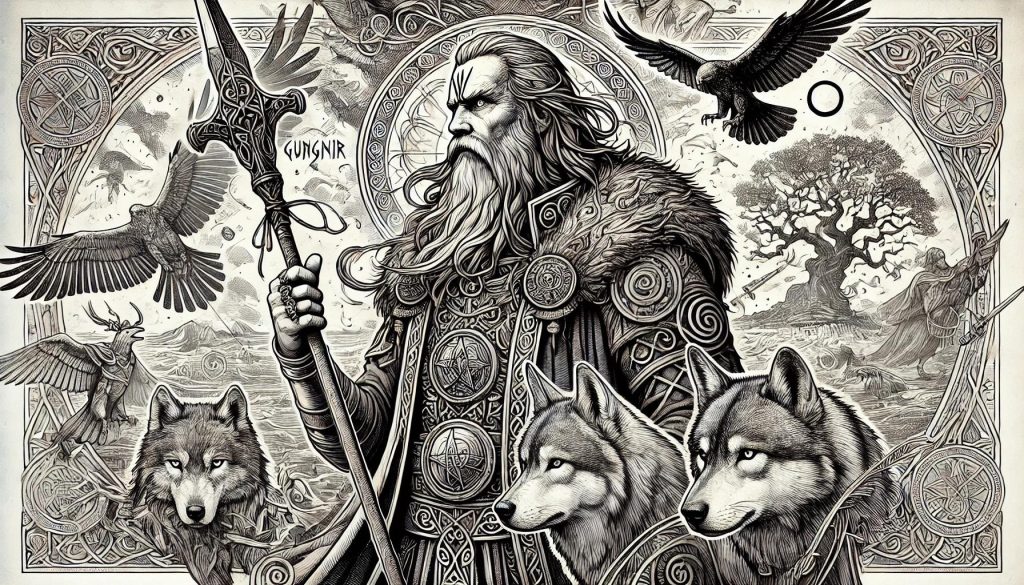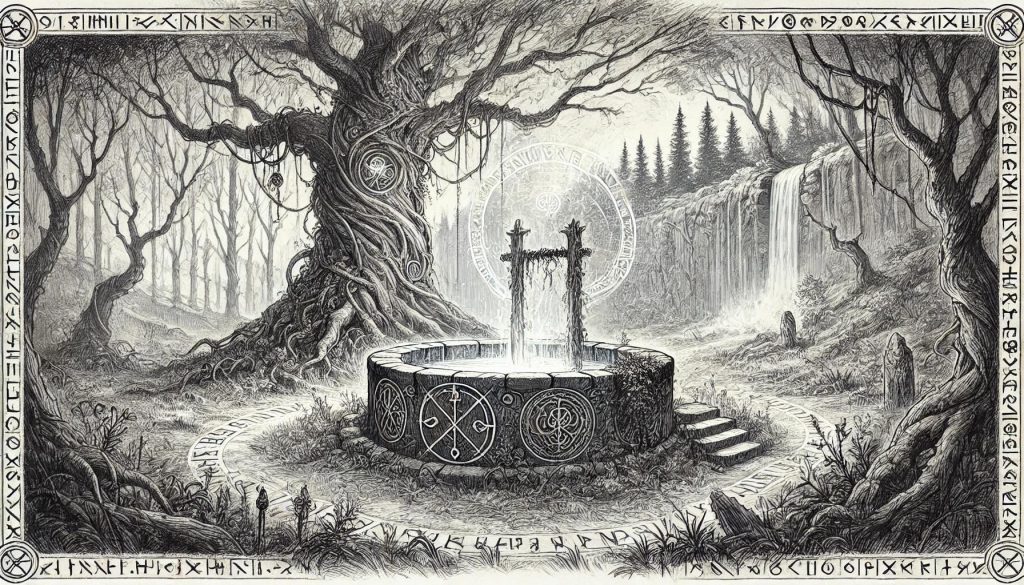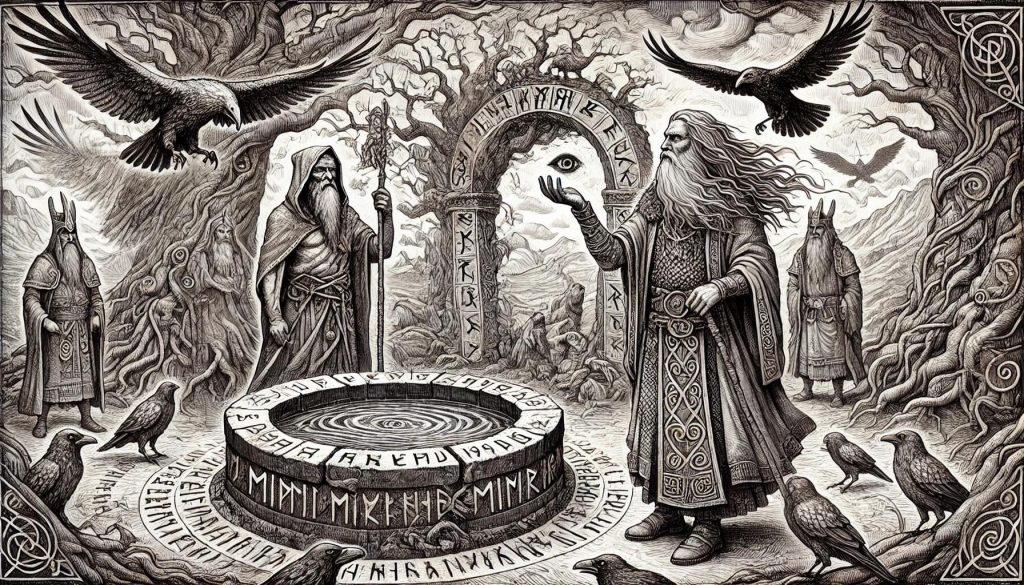Aesir Gods, Mimir, Norse Gods, Norse Mythology, Norse Runes, Odin, Tales of the Gods
How Odin Lost His Eye in Pursuit of Wisdom
In Norse mythology, Odin’s story shows the deep sacrifices for wisdom. Odin, the All-Father, loved wisdom, war, and the cosmos. He wanted to know the universe’s secrets deeply.
He went to the Well of Wisdom, guarded by Mimir. This journey cost him one of his eyes. This story is a key part of Norse and Germanic myths.
Odin’s sacrifice shows how much wisdom is worth. He lost an eye for ancient knowledge at Mimir’s Well, which shows his strong desire for knowledge and understanding of the universe. Odin sacrificed his eye to comprehend the cosmic order.
Introduction to Odin’s Quest for Wisdom
In Norse mythology, Odin, the Allfather, is a symbol of wisdom and power. He was always seeking knowledge, which changed the cosmos. His quest for wisdom was endless.
Odin was also the god of war, known for his brilliant strategies on the battlefield. But his true legacy came from his quest for wisdom. This quest led him to make big sacrifices for enlightenment.
Odin’s journey was filled with determination. He explored the realms of the Norse and other Germanic peoples for ancestral wisdom. He wanted to unlock the secrets of the tree of life and the well of knowledge. His drive for knowledge showed that he believed wisdom was the greatest power. He was ready to pay any price for it.
The Norse myths show the value of wisdom through Odin’s story, where he sacrificed his eye to gain knowledge. They highlight the sacrifices he made for knowledge. Odin’s act of giving up his eye for wisdom shows his thirst for knowledge. This act symbolizes his infinite wisdom and power.
The Significance of Wisdom in Norse Mythology
In Norse mythology, wisdom is a key part of the stories, often depicted through runes and the sacrifices made by gods like Odin and Thor. The Norse people saw wisdom as a powerful source of power and understanding. They believed it was a gift from the gods that helped them understand the cosmos. Odin, the all-father, showed a deep desire for knowledge and ancestral wisdom.
The Importance of Ancestral Wisdom
The Norse myths show the importance of ancestral wisdom, which was seen as a guiding light for those seeking knowledge. Odin’s trip to the Well of Knowledge shows how much the Norse valued the power of wisdom. He sacrificed his eye for infinite wisdom.
In Norse mythology, the eye stands for the wisdom and insight Odin gained from his big sacrifice, particularly in the tale of how Odin lost it. This act showed his thirst for wisdom. It proved the Norse belief that wisdom is the highest good. It’s the key to understanding the secrets of the cosmos.
The Tree of Life, or Yggdrasil, is at the heart of the Norse cosmos, standing tall in both myth and Asgard. It symbolizes how everything is connected and the importance of wisdom. Odin’s sacrifice and his quest for knowledge show the power of wisdom. They highlight the sacrifices one must make to get it.
Odin’s Unquenchable Thirst for Knowledge
Odin, a god in Norse mythology, was highly enthralled by knowledge. Although he was the god of war, his real strength came from his desire to learn the universe’s secrets and understand the world deeply.

He was ready to give up a lot to get the wisdom he wanted. Odin believed that wisdom was the greatest power. The more he knew about the universe, the more he could control his world.
The Norse and other Germanic peoples saw Odin as the god of wisdom. He was ready to face many challenges in his pursuit of knowledge. His eye symbolized his infinite wisdom. He lost it while trying to learn from the well of Mimir, a place full of ancestral wisdom.
Odin’s desire for wisdom was so strong that he gave up his own eye for it. This act showed his value for wisdom more than anything else and made him even more known as the god of wisdom in Norse myths.
Mimir’s Well: The Source of All Knowledge
Mimir’s Well is a key spot for wisdom and knowledge in Norse mythology. It’s also known as the “Well of Wisdom” or the “Well of Urd.” This magical spring is kept by Mimir, a wise being. It’s seen as the source of all knowledge in the Norse world.
Odin, the god of war and wisdom, sought knowledge deeply. His endless desire for wisdom led him to Mimir’s Well, and he was ready to do anything to reach its waters.
The well lies at the base of the Yggdrasil, the tree of life linking the nine realms. Its waters hold the power of ancestral wisdom, and drinking from them gives deep understanding and insight.
Odin had to make a big sacrifice to get to the well. He gave up his own eye for the chance to drink from the well of knowledge. This gave him the power and wisdom he wanted.
The well of Urd was very important to the Norse and other Germanic peoples. It was seen as the source of all wisdom and understanding. Those who could reach the waters of the well were seen as having infinite wisdom, such as when Odin sacrificed his eye in Mimir’s well.
Odin’s act of giving up his eye for knowledge shows his relentless pursuit of knowledge. This act is a symbol in Norse myths, illustrating the value of wisdom above everything else.
The Sacrifice: Odin’s Journey to Mimir’s Well
Odin, the god of war in Norse and Germanic cultures, deeply sought knowledge and wisdom and was ready to do anything to obtain it. He knew the key to wisdom was Mimir’s Well.
Odin’s path to Mimir’s Well was filled with sacrifice. He gave up his own eye for deep insights, showing how much he valued the wisdom of Mimir’s Well.

The eye symbolized power and wisdom in Norse stories. Odin was willing to lose it for knowledge. This shows his deep desire for wisdom and the sacrifices we make for it.
Odin’s journey to Mimir’s Well shows the Norse value of wisdom. His act of self-mutilation in the tale of how Odin lost his eye highlights the importance of ancestral wisdom. It shows the strength needed to pursue knowledge.
The Ultimate Sacrifice: Odin’s Eye
Odin made the ultimate sacrifice in his quest for wisdom—losing his eye. The story tells us how he gave up his eye to gain deep knowledge from Mimir’s Well, the well of wisdom.
Odin hung from Yggdrasil, the World Tree, for nine days and nights as part of his quest to understand the runes and gain profound wisdom. He meditated and thought deeply, then took out his own eye. He gave it to Mimir, the well’s guardian, as payment. This shows how much he wanted knowledge and wisdom, echoing Odin’s sacrifice to gain knowledge.
Odin’s act in Mimir’s Well is a key moment in Norse stories. It shows his deep commitment to seeking endless wisdom. By losing an eye, he got to know the well’s deep secrets, making him wiser and more powerful.
The loss of Odin’s eye is a strong symbol. It shows that true wisdom often requires a big personal sacrifice. Odin’s choice highlights the idea that gaining deep knowledge means making tough decisions and giving up something precious. This idea is important in Norse stories, showing wisdom’s value above all.
Odin’s sacrificed eye in Mimir’s Well proves his endless desire for knowledge. It shows he was ready to pay the highest price. This moment in Norse stories has lasted, with Odin’s missing eye symbolizing his quest for wisdom and the sacrifices he made for it, often involving draughts from mystical wells.
The Aftermath: Odin’s Gained Wisdom
Odin made a huge sacrifice by taking out his own eye in Mimir’s Well of Wisdom. This act gave him deep knowledge, finally satiating Odin’s relentless pursuit of wisdom. His missing eye showed his deep desire to understand the universe and the world’s order.
Odin was already known for his wisdom among the Norse and other Germanic peoples. But now, he understood the universe’s secrets even better as he sought wisdom across the realms, from Asgard to Midgard. This made him a powerful god of wisdom and war, showing how power and wisdom are connected in Norse stories.
By sacrificing his eye, Odin got access to the infinite wisdom kept by Mimir. This ancestral wisdom gave him deep insights into the Tree of Life and the cosmos. He became a master of the divine order.
The loss of his eye showed Odin’s strong commitment to learning and the value of wisdom above all else. His readiness to give up much for knowledge made him a famous god of wisdom. He was revered for his power, foresight, and infinite knowledge.
Symbolism and Legacy of Odin’s Sacrifice
In Norse mythology, Odin’s story is a powerful symbol of seeking wisdom. Odin, the god of wisdom, wanted to learn the universe’s secrets. He did this by diving deep into Mimir’s Well, a place of knowledge.
This quest cost him his eye, but he gave it willingly for wisdom. The eye in Norse stories means more than just seeing. It’s a symbol of deep understanding, a link to the divine, and seeing beyond the everyday world.
Odin’s act shows his deep commitment to knowledge, as depicted in the tale of how Odin lost his eye. It shows that true wisdom requires great personal sacrifice.
This story has gone beyond Norse tales, becoming a metaphor for self-discovery. It reminds us that gaining enlightenment often means making sacrifices. This idea is seen across cultures, showing the strength of sacrifice.
Odin’s search for wisdom reminds us of our own desire for knowledge. It shows that this desire is a key part of being human. By learning from Odin’s sacrifice, we see that seeking wisdom is a noble goal. It helps us better understand ourselves and the world.
Odin’s story teaches us about the human spirit’s power. It shows our deep need to explore the unknown, much like Odin sought to unveil the hidden runes of the cosmos. And it tells us that sometimes, the biggest wisdom comes from the most surprising places.
Conclusion: The Eternal Quest for Knowledge
The story of Odin shows us how much we value knowledge and the sacrifices we make for it. He gave up his eye for a drink from the Well of Wisdom at Mimir’s. This act shows his deep desire to understand the universe and the world tree.
This sacrifice is similar to what the Norse and other Germanic peoples value in ancestral wisdom. It shows our endless quest to learn more and understand better. Odin’s story teaches us about the power and wisdom of giving up something precious.
Like Odin, the god of war and wisdom, we must be ready to make hard choices for knowledge. This story is a metaphor for our own journey. The eye symbolizes not just seeing but gaining infinite wisdom and knowledge of the cosmos.

